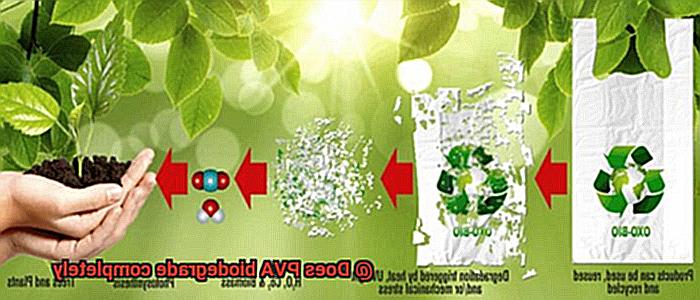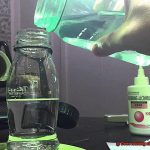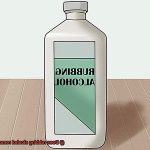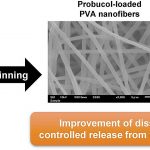Do you ever stop and wonder what happens to the materials we use every day once we toss them in the trash? It’s a daunting thought, especially considering that most plastics take hundreds of years to decompose. With over 300 million tonnes of plastic being produced globally each year, it’s no surprise that our landfills and oceans are overflowing with waste.
One type of plastic that you might be familiar with is PVA, or polyvinyl alcohol. But, does PVA biodegrade completely?
PVA is commonly found in products such as packaging materials, laundry pods, and even some surgical equipment. While it’s marketed as a “biodegradable” plastic, there’s a lot more to consider when it comes to its environmental impact.
In this post, we’ll explore the science behind PVA biodegradation and how it stacks up against other plastics. We’ll also delve into the challenges of properly disposing of PVA and whether it’s truly an eco-friendly alternative to traditional plastics.
So, if you’re curious about whether PVA biodegrades completely and how it affects our planet, keep reading.
The Complexity of PVA Biodegradation
Contents
- 1 The Complexity of PVA Biodegradation
- 2 Types of Biodegradable PVAs
- 3 Factors Affecting the Biodegradation of PVA
- 4 Does PVA Biodegrade Completely in Landfills?
- 5 The Role of Microorganisms in the Breakdown of PVA
- 6 Are There Any Eco-Friendly Alternatives to PVA?
- 7 Potential Harmful Effects of Microplastics from PVA Products
- 8 How to Properly Dispose of PVA Products
- 9 Conclusion
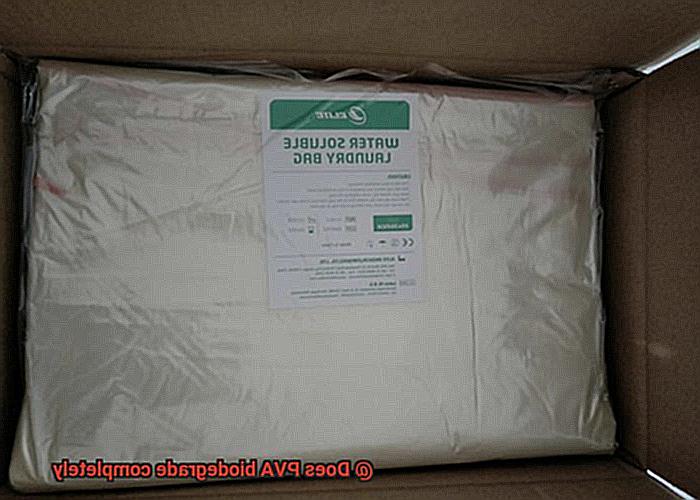
PVA, or polyvinyl alcohol, is a synthetic polymer that is widely used in various industries, including adhesives, coatings, textiles, and packaging. PVA is generally considered to be biodegradable, but the extent to which it biodegrades can vary depending on several factors. The complexity of PVA biodegradation is fascinating and worth exploring.
The first factor that affects PVA biodegradation is the environment in which it is placed. In the presence of oxygen and moisture, microorganisms like bacteria and fungi can break down PVA relatively quickly in aerobic environments such as composting facilities or soil. However, degradation can be much slower or negligible in anaerobic environments such as landfills or water bodies with low oxygen levels.
The second factor affecting PVA biodegradation is the molecular weight and degree of cross-linking of the polymer. Higher molecular weight and extensively cross-linked PVAs are more resistant to biodegradation as they are less accessible to enzymes and microorganisms that break down organic matter.
Lastly, the presence of other materials in the same environment as PVA can also affect its biodegradation. When used in conjunction with other synthetic polymers or non-biodegradable materials in products or packaging materials, it may be more difficult for microorganisms to access and break down PVA.
It’s important to note that while some forms of PVA may biodegrade under specific conditions, they still leave behind microplastic particles that can persist in the environment for years. These microplastics can be harmful to ecosystems and wildlife since they can be ingested or entangled in animal bodies.
Types of Biodegradable PVAs
Polyvinyl alcohol (PVA) is a synthetic polymer with a wide range of applications. However, traditional PVAs are not biodegradable and can harm the environment. That’s why scientists have developed various types of biodegradable PVAs to reduce the environmental impact of PVA-based products. Here are some of the categories of biodegradable PVAs available in the market today.
Water-Soluble PVA:
Water-soluble PVA is a type of biodegradable PVA that dissolves in water and breaks down into harmless substances when exposed to microorganisms in the environment. It is commonly used in adhesives, laundry bags, and packaging materials. Water-soluble PVA offers a sustainable alternative to traditional PVA that can harm aquatic life and pollute water bodies.
Thermoplastic PVA:
Thermoplastic PVA is a type of biodegradable PVA that has good mechanical properties and can degrade into carbon dioxide, water, and biomass under certain conditions. It is used to make films, fibers, and coatings that can be composted or recycled. Thermoplastic PVA offers an eco-friendly alternative to traditional plastic that can persist in the environment for centuries.
Modified PVAs:
Modified PVAs are chemically altered to enhance their biodegradability while maintaining their desirable properties. For example, polyvinyl alcohol acetate (PVAc) is a modified PVA that has good adhesive properties and can degrade into natural substances such as acetic acid under certain conditions. Modified PVAs offer a versatile solution for various industrial applications that require the benefits of PVA without harming the environment.
Enzymatically Modified PVAs:
Enzymatically modified PVAs are altered using enzymes to enhance their biodegradability. They can degrade faster than unmodified PVAs and can be used in various applications such as drug delivery systems and tissue engineering. Enzymatically modified PVAs offer a sustainable alternative to traditional polymers that can accumulate in landfills and oceans.
Plant-Derived PVAs:
Plant-derived PVAs are made from sustainable and renewable sources such as cellulose or lignin. These PVAs can biodegrade more readily in the environment and offer a more sustainable alternative to petroleum-derived PVAs. Plant-derived PVAs have the potential to reduce our dependence on fossil fuels and promote a circular economy that values waste as a resource.
Factors Affecting the Biodegradation of PVA
Polyvinyl alcohol, or PVA, is a synthetic polymer that is widely used in various applications such as adhesives, coatings, and packaging materials. However, PVA is not considered biodegradable in the traditional sense, which has raised concerns about its impact on the environment. So, what factors affect the biodegradation of PVA?
One of the most significant factors affecting the biodegradation of PVA is the type and concentration of microorganisms present. While some microorganisms such as aerobic bacteria and fungi can break down PVA, not all microorganisms are capable of doing so. Hence, the concentration of these organisms in the environment can affect the rate at which PVA breaks down.
Environmental conditions such as temperature and humidity also play an important role in the biodegradation of PVA. Higher temperatures and increased moisture levels can accelerate microbial growth and activity, thereby promoting the breakdown of PVA. Conversely, low temperatures and dry conditions may impede biodegradation.
Furthermore, the chemical structure of the PVA polymer significantly influences its biodegradability. PVA is primarily composed of repeating units of vinyl alcohol, and the degree of polymerization (DP) or number of repeating units in the polymer chain can affect its solubility and susceptibility to degradation. Lower DP values usually result in more water-soluble polymers that are more easily degraded by microorganisms.
To promote the biodegradation of PVA and reduce its impact on the environment, researchers are exploring ways to enhance microbial activity in environments where PVA waste accumulates, such as landfills and wastewater treatment plants. Additionally, there are ongoing efforts to develop more biodegradable forms of PVA that can break down more easily and quickly in the environment.
Does PVA Biodegrade Completely in Landfills?
Polyvinyl acetate (PVA) is a versatile and strong adhesive that is used in various applications. Despite its usefulness, there are concerns about its impact on the environment, particularly its biodegradability in landfills. So, let’s explore the debate surrounding PVA’s ability to break down completely in landfills.
While PVA can biodegrade in natural environments like soil and water, the conditions in landfills are different due to the absence of oxygen and sunlight. Consequently, PVA may take longer to decompose compared to other materials. However, research shows that factors such as temperature, moisture, and microbial activity influence PVA’s biodegradability in landfills. For example, higher temperatures and moisture levels can accelerate the degradation process.
But here’s where things get interesting – we still don’t know the extent to which PVA biodegrades in landfills. Some experts suggest that PVA may leave behind microplastics or other harmful byproducts that could harm the environment. In short, even if PVA eventually breaks down in landfills, it may still pose a threat to our planet.
So how can we mitigate this issue? Individuals and industries can make a difference by considering alternative solutions or disposal methods for PVA-containing products. Recycling or composting are more environmentally friendly options than disposing of them in landfills.
The Role of Microorganisms in the Breakdown of PVA
While PVA is known for its excellent adhesive properties, its non-biodegradable nature has raised concerns about its impact on the environment. However, fear not. Microorganisms are here to save the day by playing a crucial role in the breakdown of PVA.
Microorganisms are tiny organisms such as bacteria and fungi that live in the environment. When PVA is released into the environment, microorganisms break down the polymer chains into smaller molecules through biodegradation. During this process, microorganisms use PVA as a source of carbon and energy to fuel their growth and metabolism.
But wait, there’s more. Biodegradation of PVA by microorganisms can occur under both aerobic and anaerobic conditions. Under aerobic conditions, microorganisms require oxygen to break down PVA completely. They oxidize the polymer chains into carbon dioxide and water, leaving no trace of PVA behind. On the other hand, under anaerobic conditions, microorganisms use alternative electron acceptors such as nitrate or sulfate to degrade PVA into simpler compounds.
Several factors affect the rate of biodegradation of PVA by microorganisms. Temperature, pH, nutrient availability, and the type of microorganism present in the environment all play a role. Studies have shown that certain species of bacteria and fungi are more effective in breaking down PVA than others. For example, Bacillus subtilis and Pseudomonas fluorescens have been found to degrade PVA efficiently.
To summarize, microorganisms are essential for the breakdown of PVA. This suggests potential for developing biodegradable PVA-based materials that can be used in various applications. However, more research is needed to optimize conditions for PVA biodegradation and identify microorganisms that can efficiently degrade PVA. So next time you use PVA-based products, remember the vital role of microorganisms in their potential breakdown and consider alternative disposal methods such as recycling or composting.
Are There Any Eco-Friendly Alternatives to PVA?
Well, look no further, as I am here to share with you some of the most popular eco-friendly options available.
Firstly, let’s talk about natural adhesives. These biodegradable adhesives have been in use for centuries and are made from materials such as vegetable starch or animal hide glue. They offer a sustainable option for those who want to reduce their carbon footprint while still getting the job done. However, it’s worth noting that they may not be as strong as traditional PVA glue and may not work on all surfaces.
Another eco-friendly alternative is water-based adhesives made from renewable resources like soybeans or corn. These adhesives are free from harmful chemicals and are specifically designed to have a low impact on the environment. They’re also versatile and can be used on a variety of materials. However, they may take longer to dry than PVA glue.
For those seeking a more innovative solution, bio-based adhesives made from plant-based materials are also available. These adhesives are biodegradable and offer a great eco-friendly alternative to PVA glue. However, they can sometimes be more expensive and may not be as readily available as other options.
It’s important to remember that not all eco-friendly adhesives are equal in quality or environmental impact. When selecting an eco-friendly adhesive, make sure to do your research and choose a product that is both effective and kind to the environment.
Potential Harmful Effects of Microplastics from PVA Products
Microplastics are small pieces of plastic that measure less than 5 millimeters in size. When PVA products break down, they can form tiny plastic particles that can persist in the environment for hundreds of years. These particles can be ingested by marine animals, causing harm to their digestive systems, and eventually end up in human consumption.
In addition to its contribution to microplastic pollution, PVA products are not entirely harmless to the environment. PVA coatings and films release volatile organic compounds (VOCs) during production and use, which can contribute to air pollution and have been linked to health problems such as respiratory issues and cancer.
The potential harmful effects of microplastics from PVA products highlight the need for more sustainable alternatives and responsible disposal practices. Here are some eco-friendly options to consider:
- Natural adhesives made from vegetable starch or animal hide glue
- Water-based adhesives made from renewable resources like soybeans or corn
- Bio-based adhesives made from plant-based materials
Proper disposal of PVA products is also crucial to reduce their impact on the environment. Instead of throwing them in the trash, look for recycling programs or facilities that accept PVA products for proper disposal.
How to Properly Dispose of PVA Products
Proper Disposal of PVA Products: A Guide for Environmentalists
PVA products are a popular choice for adhesives, coatings, and binders in various industries. However, proper disposal of these products is crucial to minimize their negative impact on the environment. In this guide, we’ll explore the steps you can take to dispose of PVA products safely and responsibly.
Check with Your Local Waste Management Facility
Before disposing of PVA products, it’s important to check with your local waste management facility. Some facilities may have special programs or instructions for disposing of PVA products. By following their guidelines, you can ensure that the product doesn’t end up polluting the environment.
Recycle When Possible
Recycling is an excellent way to reduce waste and protect the environment. Some PVA products, such as glue bottles and packaging, may be able to be recycled depending on your location and recycling program. It’s essential to check with your local recycling center to see what types of PVA products they accept and how to prepare them properly for recycling.
Dispose of PVA Products in Regular Trash
If local waste management facilities don’t accept PVA products or they cannot be recycled, the next best option is to dispose of them in regular household trash. However, it’s crucial to take some precautions before doing so. First, try to minimize the amount of PVA waste you generate by using only what you need and storing unused product properly. Second, wrap the PVA product securely in a plastic bag or other sealed container before placing it in the trash.
Follow Hazardous Waste Guidelines
In some cases, PVA products may be considered hazardous waste due to their chemical composition. If this is the case, it’s essential to follow the guidelines set by local hazardous waste disposal authorities. Hazardous waste should never be disposed of with regular household waste as it can pose a significant risk to human health and the environment.
-_eGOyAiNIQ” >
Conclusion
In conclusion, determining whether PVA biodegrades completely is a complex issue with several variables to consider. While PVA is marketed as a biodegradable plastic, its environmental impact depends on factors such as the environment it’s exposed to, molecular weight and degree of cross-linking of the polymer, and other materials present.
Even if some forms of PVA do biodegrade under specific conditions, they still leave behind microplastic particles that can persist in the environment for years. This is why individuals and industries must consider alternative solutions or disposal methods for PVA-containing products.
Fortunately, there are several types of biodegradable PVAs available today that offer a sustainable alternative to traditional PVAs. These include water-soluble PVA, thermoplastic PVA, modified PVAs, enzymatically modified PVAs, and plant-derived PVAs.
It’s important to note that recycling or composting are more environmentally friendly options than disposing of PVA products in landfills. By doing so, we can take small steps towards creating a cleaner and healthier planet for future generations.
Lastly, microplastics from PVA products pose potential harmful effects on ecosystems and wildlife. Therefore, it’s crucial to practice responsible disposal practices and consider eco-friendly alternatives to minimize their negative impact on the environment.

